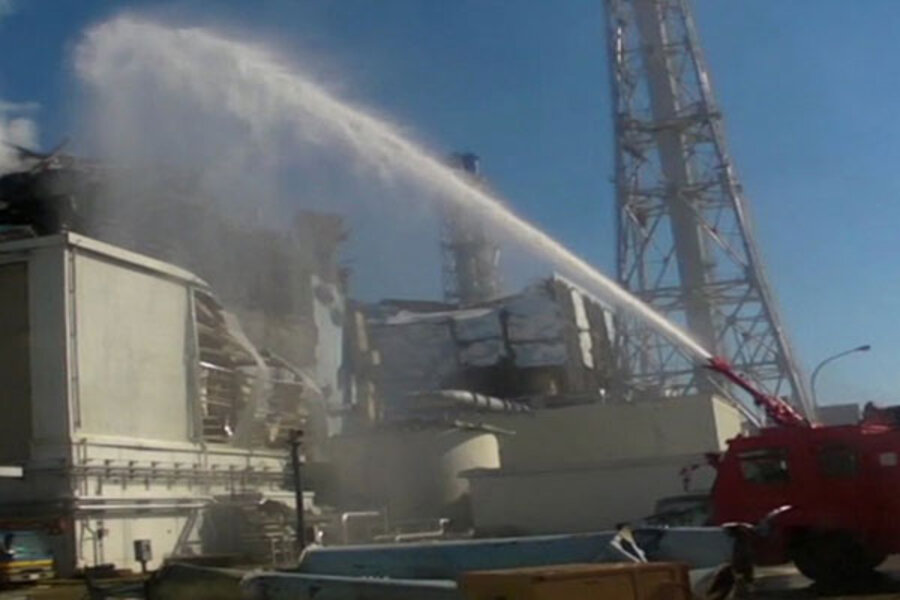Japan nuclear crisis: Closer to stabilization, but what about food supply?
Loading...
| Tokyo
The most dangerous of Japan’s stricken nuclear reactors at the Fukushima Daiichi Nuclear power plant appeared to stabilize Saturday, as firemen sprayed more water on spent fuel rods to prevent them from overheating and spreading potentially deadly radiation.
The situation at reactor No. 3 “is stabilizing somewhat,” cabinet spokesman Yukio Edano told a press conference, signaling a rare success in the efforts to prevent a meltdown.
Meanwhile, engineers managed to hook up an external power cable to the crippled plant’s central transmission point, according to the plant’s operator. They hope to test supply lines inside the plant on Sunday and then to restore power to water pumps in reactors 1, 2, 3, and 4.
Japan nuclear crisis: A timeline of key events
The top priority has been to ensure that spent fuel rods in reactor No. 3’s cooling pond are under as much water as possible. That reactor was using a mixture of uranium and much more toxic plutonium fuel when an earthquake and tsunami hit it last Friday.
Food supply
Mr. Edano sought to allay fears over the first reported discovery that foodstuffs from the area around the plant had been contaminated with radioactivity.
Milk and spinach from farms in Fukushima and a neighboring prefecture had been found to contain radiation at levels above the legal norm, Edano said, but this “would not affect consumers’ health.”
Officials later announced that they were forbidding the sale of all food products from Fukushima prefecture pending the collection of further data, according to a statement on the International Atomic Energy Agency's website.
The political front
Meanwhile, Prime Minister Naoto Kan’s bid to form a government of national unity to deal with the crisis appear to have come to naught in the face of opposition reluctance.
The leader of the Liberal Democratic Party, the largest opposition group, Sadakazu Tanigaki, telephoned Mr. Kan Saturday to reject the idea, according to the Jiji news agency.
Before the earthquake and tsunami, Kan’s popularity had slumped to around 20 percent and his government was widely considered on the brink of collapse.
Japan nuclear crisis: A timeline of key events
The crisis has given him a window of opportunity to redeem himself, although many voters have been frustrated by how slowly the authorities initially responded to the disaster, and by how parsimonious officials were with information.
Poor communications, bad weather, and insufficient organization slowed the flow of food and other relief supplies to many isolated towns and villages. Even in larger cities shops only began to open toward the end of the week. Some 400,000 people are living in shelters or with host families and experiencing shortages of electricity, food, and gasoline in the affected area.
Outside of the evacuation zone
Evacuees who managed to get to parts of the country unscathed by the disaster, however, are now being made as comfortable as they can be sleeping on blankets laid out on the floors of gymnasiums, schoolrooms, and community halls.
In the western prefecture of Niigata, for example, where 15,000 people have fled their homes either because of the tsunami or the threat of radiation from the Fukushima Daiichi plant, private companies have donated food and city governments have drawn on the emergency stocks of blankets and relief supplies that they keep in case of situations like this.
At one city gym in Niigata city, where 495 people are sheltering, volunteers handed out soap and other toiletries Friday afternoon while municipal officials prepared hot rice and miso soup.
“We are more or less alright for food,” says the official running the shelter who identified himself only as Mr. Kato, who normally works in the public relations department at Niigata city hall. “The quality is not great, but we have enough.”
The shelter is offering other services too. In a corner of the foyer stood several large cardboard boxes housing the pet dogs that some evacuees had brought with them. On a table lay piles of the local newspaper available for free.
Also available were photocopied maps of the city, with directions to the nearest coin-operated laundry and to the radiation testing station where evacuees can have their radioactivity levels checked. And with the sort of attention to detail that displaced people in the quake zone can still only dream of, the shelter management had installed an electronic parking ticket machine to distribute free tickets to the gymnasium parking lot for its temporary residents.





